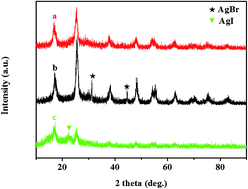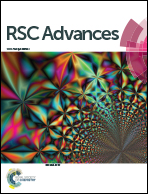A new fabrication of AgX (X = Br, I)–TiO2 nanoparticles immobilized on polyacrylonitrile (PAN) nanofibers with high photocatalytic activity and renewable property
Abstract
A highly efficient visible light-driven AgX–TiO2/PAN (X = Br, I) photocatalyst was synthesized by means of a combination of the electrospinning technique, solvothermal synthesis, physical adsorption and gas/solid reaction. The components, morphological and optical properties of the photocatalysts were characterized by X-ray diffraction (XRD), field-emission scanning electron microscopy (FE-SEM), transmission electron microscopy (TEM), UV-vis diffuse reflectance spectroscopy (DRS) and Fourier transform infrared spectroscopy (FTIR). The as-prepared composites exhibited excellent photocatalytic efficiency for the degradation of methyl orange (MO), methylene blue (MB), acid red 18, sodium fluorescein, xylenol orange and phenol under visible light irradiation. Compared with pure PAN, AgX/PAN and TiO2/PAN, AgX–TiO2/PAN showed much higher photocatalytic activity in degrading MO. In addition, AgX–TiO2/PAN had a certain photochemical stability and could be regenerated easily. The application of PAN nanofibers made it easy to separate the catalysts from an aqueous solution without any loss. The degradation of MO in the presence of different scavengers suggested that holes and ˙O2− were the main reactive species and holes played the predominant role. Thus, a possible two-stage photocatalytic mechanism associated with AgX–TiO2/PAN was proposed.


 Please wait while we load your content...
Please wait while we load your content...